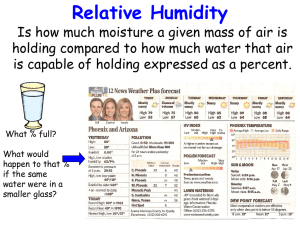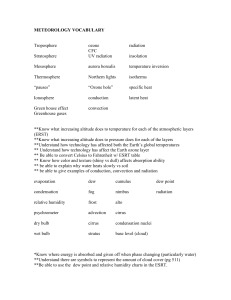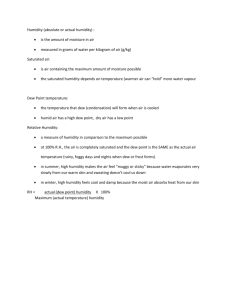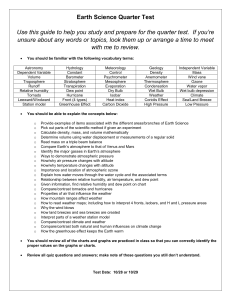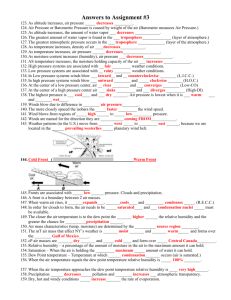Relative humidity, dew point and homes
advertisement
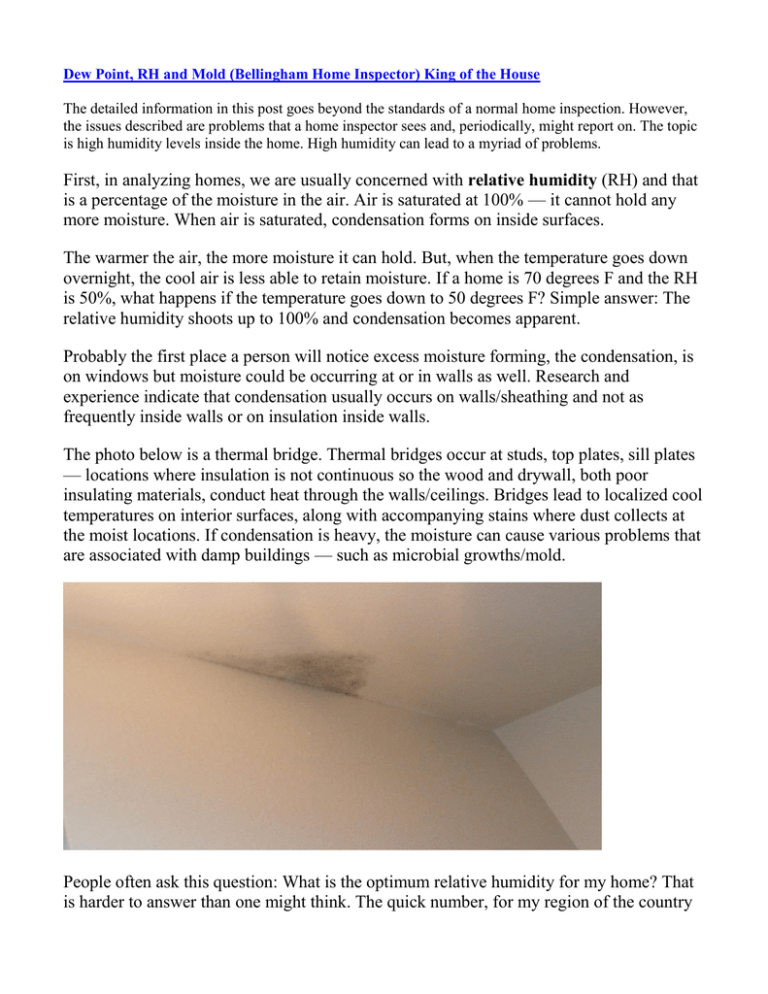
Dew Point, RH and Mold (Bellingham Home Inspector) King of the House The detailed information in this post goes beyond the standards of a normal home inspection. However, the issues described are problems that a home inspector sees and, periodically, might report on. The topic is high humidity levels inside the home. High humidity can lead to a myriad of problems. First, in analyzing homes, we are usually concerned with relative humidity (RH) and that is a percentage of the moisture in the air. Air is saturated at 100% — it cannot hold any more moisture. When air is saturated, condensation forms on inside surfaces. The warmer the air, the more moisture it can hold. But, when the temperature goes down overnight, the cool air is less able to retain moisture. If a home is 70 degrees F and the RH is 50%, what happens if the temperature goes down to 50 degrees F? Simple answer: The relative humidity shoots up to 100% and condensation becomes apparent. Probably the first place a person will notice excess moisture forming, the condensation, is on windows but moisture could be occurring at or in walls as well. Research and experience indicate that condensation usually occurs on walls/sheathing and not as frequently inside walls or on insulation inside walls. The photo below is a thermal bridge. Thermal bridges occur at studs, top plates, sill plates — locations where insulation is not continuous so the wood and drywall, both poor insulating materials, conduct heat through the walls/ceilings. Bridges lead to localized cool temperatures on interior surfaces, along with accompanying stains where dust collects at the moist locations. If condensation is heavy, the moisture can cause various problems that are associated with damp buildings — such as microbial growths/mold. People often ask this question: What is the optimum relative humidity for my home? That is harder to answer than one might think. The quick number, for my region of the country and provided by the NW Clean Air Agency, is 30% to 50%. But, a reading as high as 60% is not usually a cause for much alarm. My experience is that those numbers work well in the summer, when we are not heating the house, and when the home does not cool off so much overnight. Those same readings can be too high in the winter. Many factors come into play. Keep in mind that air is saturated and expelling moisture when relative humidity is 100%. The dew point is the temperature at which water condenses. Some people think the dew point is a low temperature and that such a temperature could never occur inside the home. It is more complicated than that. The RH gauge, below, has an RH of 40% and a temperature rounded to 69 degrees F. The dew point is 44 degrees. The temperature would have to fall to 44 degrees before condensation would form at inside surfaces. This example displays a pretty typical RH and temperature based on my studies in this region of the country. In the next example, RH is a bit higher, 56%, and the temperature is up less than 2 degrees. That change in the equation leads to a dew point of 53 degrees F. When the mercury hits 53 degrees, with that much moisture in the air, condensation forms inside the house. Now let’s take a big jump. These readings are possible inside a home that has excessive moisture. With RH at 77% and a temperature of 73 degrees F, the dew point is 66 degrees F — two degrees less than the 68 degrees that many people consider to be the ideal thermostat setting. This is problematic because if the inside temperature drops to 66 degrees overnight, condensation will form on inside surfaces. Especially so in winter, it is beneficial keep the relative humidity low which drives down the dew point at a residence. Here in the Pacific Northwest, in fall and winter, it is more practical to keep a house somewhere above 44 degrees overnight than it is to keep it at, or above, 66 degrees. It is an oddity but some homes that seem like they should have mold growth do not, and the opposite is true as well. Being aware of the correlation between RH and dew point helps a person better understand why excess moisture can lead to damaged sheet rock, wood rot, mildew, mold, rust on metal, shrinking or expanding wood, reduced thermal resistance of insulation and musty odors. Frequently people ask what causes high relative humidity. It is not always easy to say but some of the usual suspects are showers, baths; cooking; washing clothes, dishes, floors and walls; breathing, perspiring; pets; uncontrolled surface water, wet crawl spaces and basements. If you are interested in figuring out the RH and the dew point at your home, purchase a relative humidity gauge (hygrometer) at an electronics shop or Online. Or, for under $100, you can purchase a more accurate instrument such as the one pictured above. To compute the data that you collect, search Online for a "psychrometric chart" or an interactive dew point calculator. Locally, if I have concerns about moisture inside a home, I often suggest that clients should contact the Building Performance Center. It is a private, non-profit organization that employs building scientists who will help homeowners and tenants troubleshoot complicated humidity, air quality or mold issues. Steven L. Smith Bellingham WA Home Inspections Thanks for stopping by, Steven L. Smith Rev: October 2, 2012
